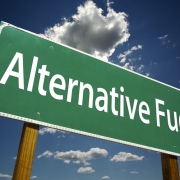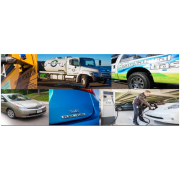At MEC, our job is to keep tabs on energy use in the central Midwest, but why should that matter? Because the ways that people and businesses use energy can affect lives. Technology has yet to come up with a solution that moves people and goods without releasing some sort of air pollution, and air pollution affects human health. The problem is that every power source that can power a vehicle will create emissions and will have a carbon footprint, even electric vehicles. There are, however, many alternative fuel options that are far cleaner than gasoline and diesel. If you’re looking for a vehicle that produces less emissions, there are a lot of factors to consider when making your decision.
Let’s compare the different ways that the energy we use affects our health. In 2017 the emissions from vehicles on the road passed up the amount of emissions released from power stations. That switch has shown up as health problems, such as the increase of child asthma cases for families living near highways and railroads. That’s simply because vehicle emissions get concentrated in the air around the places that people and goods get transported. Transportation emissions are now the #1 source of greenhouse gases too, making it globally important to choose our transportation wisely. For the sake of our local and global health, we must decide to make transportation cleaner. The question now is how.
For some, their ideal chosen solution is to walk or bike more places, and to only shop for things in stores within walking distance of their house. But what if you need transportation? Remember that COVID shutdowns produced sudden, startling air quality improvements the likes of which we haven’t seen in decades. As residents of Los Angeles and New York saw with their own eyes, less vehicles on the road immediately improved their air quality, even in heavily polluted cities. But the shutdown of society isn’t a realistic model for fighting climate change in the long run. Movement of people and goods still must happen. Are there cleaner solutions than what’s commonly used to move people and goods right now? The simple answer is yes. For a more complete answer, here are options that make sense for our health, the economy and the environment.
Electric vehicles (EVs), which plug in to an electrical supply to “fuel up,” are creating a lot of buzz right now, and rightly so. All-electric vehicles have zero emissions coming out of their tailpipes, so they appear to be the magic bullet for clean air around our roadways. Plug-in hybrids are also great, in that they make use of electricity as a primary fuel, but are equipped with a fuel tank as a backup for longer trips. EVs are great as urban or suburban family cars, transit buses, or local delivery trucks that rack up limited daily miles before returning to base to recharge. Plus, long-range batteries, fast charging stations, and new heavy truck technologies are under rapid development, so the list of compatible uses is getting longer by the day.
You may not realize that you can help your electrical grid become more efficient with the electricity being generated just by owning an EV and charging it at night. The electrical grid is set up to estimate how much power is needed, and then generate slightly more than that amount to provide for our electricity needs. Whatever electricity is generated at power plants either gets used, or it dissipates with non-use. If you charge an EV overnight, it utilizes that energy that would otherwise be wasted.
Biofuels are another cleaner transportation option available now. They come from farm-produced food commodity byproducts, they emit substantially less air pollution when burned, and they’re surprisingly less expensive than the worst emission producers, gasoline and diesel. Ethanol and biodiesel have been around for a while, and just like your cell phone, their design and our use of them has greatly improved over the last 20 years.
In the 1990s, car manufacturers started figuring out how to protect the insides of vehicle fuel lines from the extra corrosiveness of ethanol blends, which is basically ethyl alcohol (moonshine!) mixed with gasoline. By 2012, ethanol had busted into the mainstream, and most vehicle manufacturers now support up to 15% ethanol (E15). To save money and get a cleaner burn in your vehicle, look for the E15 label on pumps at gas stations. The added ethanol increases the octane, which is actually better for modern, more fuel-efficient engines. Plus, the more ethanol mixed into gasoline, the fewer harmful, carcinogenic gases get released into the air around it. All of this is why today most gasoline at the pump already has 10% ethanol in it. You can choose higher blends if your vehicle is rated to use them. Then it’s a matter of finding a local gas station where that blend is available to support your choice. When you’re buying a family vehicle and want the option of using high blends of ethanol (E20-E85), ask to look at “flex-fuel” options at your dealership. Typically, a flex-fuel vehicle will have a yellow gas cap, indicating that you can safely use blends up to 85% ethanol, wherever you should find them.
Biodiesel is another clean fuel option. It can be used in most diesel-fueled vehicles, and also supports the regional economy as a value-added farm product. It is a renewable fuel made from vegetable oils, primarily soybean and sometimes corn oil, but also from recycled cooking oil and waste fat. No, you can’t just pour the grease from your deep-fried turkey into your pickup. Just like petroleum, it has to be refined first, and biodiesel at the pump has excellent quality controls. Most diesel engines can use blends of biodiesel and petroleum diesel up to 20% (called “B20”), which can be found at some area fuel stations. It’s also an easy drop-in fuel option for farming equipment, heavy-duty freight engines, and industrial work trucks. Fortunately for companies with large industrial fleets, fuel distributors are ready today to bring biodiesel or ethanol blends directly to industrial sites.
Natural gas, or methane, the same fuel that cooks your food and heats your home, can be used in specialized “Near-Zero” engines that are made to burn it. Natural gas is a clean burning fuel with much lower emissions than plain petroleum diesel. It comes in two possible transportation fuel products: compressed natural gas (CNG) and liquid natural gas (LNG). Both are available in renewable options. More on that later. Natural gas is widely available through existing pipelines, and fuel costs are lower and more stable than diesel. It’s a great option for heavy vehicles such as freight trucks, transit buses, and refuse trucks. And, because the engines are quieter than diesel engines, that 6 am trash pickup won’t disturb your sleep. CNG engines eliminate nearly all smog-forming pollutants—hence the trade name “Near-Zero” engines. While CNG is available to the general public at some area fueling stations and you can convert some cars and trucks to use CNG, it usually only makes financial sense for high-mileage vehicles or fuel-hungry service providers to use it. A number of our regional governments and service providers are already using CNG today.
Making natural gas more climate-friendly is a priority for many people and government agencies. The ultimate low-hanging fruit in reducing climate emissions is renewable natural gas (RNG) which involves collecting and then using methane, a greenhouse gas far more potent than carbon dioxide. Methane comes from sources other than just underground and a whopping 39% of natural gas vehicle fuel comes from renewable sources like landfill gas, which comes out of landfills whether it’s used or not. Other sources of RNG include wastewater treatment plants, food waste and agricultural byproducts. Available in both liquid and compressed forms, RNG is rapidly gaining market share because of its ecologically friendly procurement methods. Done right, RNG can even have a negative carbon footprint!
Which fuel heats your grill AND gets your kids to school? Propane (also called autogas for transportation uses). It’s yet another cleaner burning, low-emission fuel with notably quieter operation than diesel fuel. That makes for a much quieter ride, which drivers appreciate. Because of that stealthy quality, propane is a popular option for fleets of larger vehicles, especially school bus fleets. Propane on an autogas transportation contract costs much less than diesel, so school districts can save substantially on fuel costs. Switching to propane also means that students don’t have to breathe diesel exhaust while waiting for their buses. Propane is widely available, with distribution networks already in place nationwide. Like with CNG, you can convert some personal vehicles to run on propane, and though a bit harder to find than gasoline, it is available at some retail fuel stations. Not to be outdone by its gaseous counterpart RNG, renewable propane is an emerging product. As icing on the cake, propane engine manufacturers are actively developing their own version of a “near-zero” engine, expected to be available in coming years.
Though none of these options are ‘perfect’, they each offer substantial benefits compared to conventional fuels—lower cost, longer engine life, quieter operations, lower emissions, and economic benefits to the farm economy. Though no single alternative fuel captures all these benefits, there’s likely an option that’s almost perfect for your needs. When more people, businesses and government fleets embrace alternative-fuel options, the owners/operators enjoy lower costs, softer road noise and less air pollution. And with more investment in alternative fuels, research and development efforts continue to make every available option even better. Big picture: petroleum diesel is far and away the worst culprit in making our air harder to breathe. In order to cut down on the emissions released into the air by our transportation practices, it’s necessary for all of us to recognize and support any and all options. We can’t yet eliminate vehicle emissions, but moving in that direction is far easier than you might think.
For more information on alternative fuels and vehicles, check out the Alternative Fuels Data Center.


